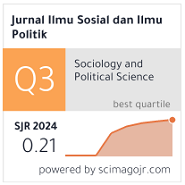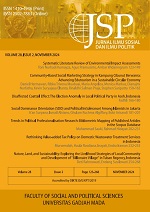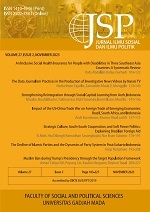The Feminisation of Indonesia’s Political Parties: Toward Feminised Parties?
Esty Ekawati(1*), Sri Budi Eko Wardani(2), Lili Romli(3), Nur Iman Subono(4)
(1) National Research and Innovation Agency BRIN, Indonesia.
(2) Departement of Political Science, Faculty of Social and Political Sciences, Universitas Indonesia, Indonesia.
(3) National Research and Innovation Agency (BRIN), Indonesia.
(4) Departement of Political Science, Faculty of Social and Political Sciences, Universitas Indonesia, Indonesia
(*) Corresponding Author
Abstract
The political representation of women in the Indonesian parliament has increased since the implementation of the affirmation policy through quotas, although the number has not yet reached 30%. In addition, the percentage of women placed in the management structure of political parties has also increased. In addition, the percentage of women's candidacy in each election period also showed an increasing trend. This article aims to analyse the feminisation process that occurred in ten political parties in the Indonesian reform era using the model of party responsiveness introduced by Lisa Young. By using a qualitative approach, in which data were obtained from interviews, party statutes (AD/ART), and documents of the Special Committee for the 2017 Election Bill, it was found that the feminisation of political parties in Indonesia is divided into two categories, namely responsive and co-optive. The difference in the level of feminisation is due to differences in party responses to three things namely, the number of women in the party’s structure, quota rules, and party responses to pro-women policies. Based on the mapping of political parties in Indonesia using a model of party responsiveness, it can be said that political parties experience limited feminisation where only the representational dimension shows a high tendency. However, in the policy dimension, most parties have a negative response. Therefore, the feminisation that occurs is half-hearted.
Keywords
Full Text:
PDFReferences
Bratton, K. A., & Ray, L. P. (2002). Descriptive Representation, Policy Outcomes, and Municipal Day-Care Coverage in Norway. American Journal of Political Science, 46(2), 428. https://doi.org/10.2307/3088386
Budiman, C. (2021). Feminist Research in Cultural Studies: Points of Convergence and Contributions. Jurnal Kawistara, 11(1), 102–113.
Campbell, R. (2016). Representing Women voters: the Role of the Gender Gap and the Response of Political Parties. Party Politics, 22(5), 587–597.
Childs, S. (2008). Women and British Party Politics: Descriptive, substantive and symbolic representation. In Women and British Party Politics: Descriptive, Substantive and Symbolic Representation. https://doi.org/10.4324/9780203019443
Childs, S., & Kittilson, M. C. (2016). Feminizing Political Parties: Women’s Party Member Organizatio n within Parliam entary Parties. Party Politics, 22(5), 598–608.
Childs, S., & Webb, P. (2012). Sex, Gender and the Concervative Party: From Iron Lady to Kitten Heels. Palgrave Macmillan.
Dahlerup, D., & Layenaar, M. (2013). Breaking Male Dominance in Old Democracies. In Breaking Male Dominance in Old Democracies. Oxford University Press. https://doi.org/10.1093/acprof:oso/9780199653898.001.0001
Document of the Special Committee Meeting on the Election Bill. (2017).
Hinojosa, M. (2012). Selecting Women, Electing Women: Political Representation and Candidate Selection in Latin America. Temple University Press.
Hoodfar, H., & Tajali, M. (2011). Electoral Politics: Making Quotas Work for Women. Women Living Under Muslim Laws.
Hughes, M. M., & Paxton, P. (2019a). The Palgrave Handbook of Women’s Political Rights. In The Palgrave Handbook of Women’s Political Rights. Palgrave Macmillan UK. https://doi.org/10.1057/978-1-137-59074-9
Hughes, M. M., & Paxton, P. (2019b). The Political Representation of Women over Time. In S. Franceschet, M. L. Krook, & N. Tan (Eds.), The Palgrave Handbook of Women’s Political Rights (pp. 33–51). Palgrave Macmillan.
Hurriyah, & Wildianti, D. (2020). Partisipasi tanpa Representasi: Analisis Relasi Organisasi Sayap Perempuan dengan Partai Politik di Indonesia. Prosiding Simposium Hukum Tata Negara: Penataan Pengaturan Organisasi Sayap Partai Politik.
Jabeen, M., & Awan, S. M. (2017). Gender Quotas as an Instrumen for Women’s Empowerment in Legislatures. FWU Journal of Social Sciences, 11(1), 132–142.
Karim, A. (2014). Feminisme: Sebuah Model Penelitian Kualitatif. SAWWA, 10(1), 83–98.
Krook, M. L. (2014). Electoral Gender Quotas: A Conceptual Analysis. Comparative Political Studies, 47(9), 1268–1293. https://doi.org/10.1177/0010414013495359
Kunovich, S., & Paxton, P. (2005). Pathways to power: The role of political parties in women’s national political representation. American Journal of Sociology, 111(2), 505–552. https://doi.org/10.1086/444445
Lee, A. (2018, October 9). Jalan KeterwakilanPerempuan. https://www.Kompas.Id/Baca/Utama/2018/10/09/Jalan-Keterwakilan-Perempuan/.
Lovenduski, J. (2005). Feminizing Politics. Polity Press.
Margret, A., Novitasari, M., Samosir, H., Kusuma, T. H., & Rahmadiyansyah, Y. (2022). Menyoal Data Representasi Perempuan di Lima Ranah. Cakra Wikara Indonesia.
Neuwman, W. L. (2003). Social Research Method: Qualitative and Quantitative Approaches (5th ed.). Allyn and Bacon.
OSCE. (2014). Handbook on Promoting Women’s Participation in Political Parties. OSCE Office for Democratic Institution and Human Rights.
Phillips, A. (1995). The Politics of Presence. Oxford University Press.
Piscopo, J. M. (2011). Rethinking descriptive representation: Rendering women in legislative debates. Parliamentary Affairs, 64(3), 448–472. https://doi.org/10.1093/pa/gsq061
Siddiqui, R. (2023). Feminization of Politics: Claiming a Seat at the Table. https://Moderndiplomacy .Eu/ 2023/ 04/ 25/ Feminization-of-Politics-Claiming-a-Seat- at-the-Table/.
Tasdemir, S. (2013). The Feminization of pro- Kurdish Party Politics in Turkey: the Role of Women Activists. University of Exeter.
Wylie, K. N. (2018). Party Institutionalization and Women’s Representation in Democratic Brazil. Cambridge University Press.
Young, L. (2000). Feminists and party politics. UBC Press.
Interviews
Hetifah Syaifuddian, Interviewed by Esty Ekawati, April 17, 2021. Jakarta.
Siti Masrifah, Interviewed by Esty Ekawati, December 4, 2021, Jakarta.
Article Metrics
Refbacks
- There are currently no refbacks.
Copyright (c) 2025 Jurnal Ilmu Sosial dan Ilmu Politik

This work is licensed under a Creative Commons Attribution-ShareAlike 4.0 International License.























